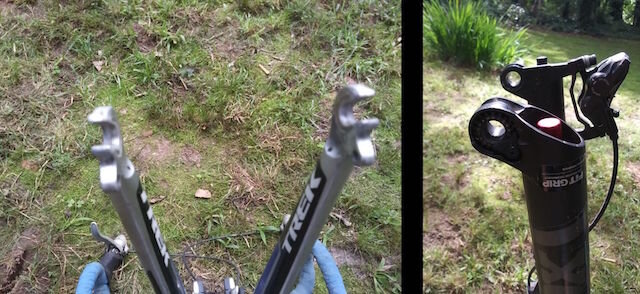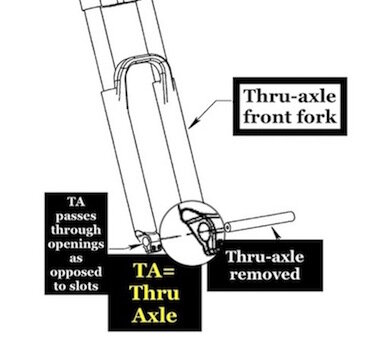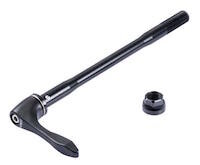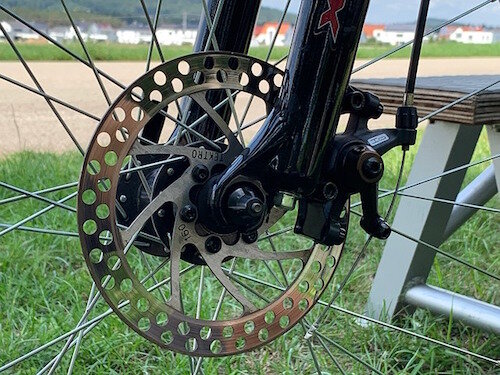What is a thru-axle on a mountain bike?
A thru-axle (TA) is a wheel attachment system that secures a wheel on a hub between a pair of dropouts on a bicycle frame or fork. The thru-axle threads directly through the fork/frame holes and into the wheel hub, which makes the wheel secure from detaching.
This axle is a large diameter axle with a threaded side, which makes it easily distinguishable from the common quick-release skewer.
(Right) Thru axle = holes
(Left) Quick Release Skewer = Slots
Thru-axle Simplified
- A thru-axle is a type of wheel attachment system where the axle shaft goes through one side of the fork then through the hub and is screwed into the other side of the fork.
benefits of a thru-axle
The common quick release skewer
Through-axle systems have been around for nearly 20 years and have been mostly used on downhill and freeride mountain bikes until recently.
Downhillers were breaking quick-releases (QR), which resulted in wheels popping off the frame. Downhill bikes were responsible for the redesign from the standard U-shaped dropout (for quick releases) to holes, which subsequently created the re-engineered thicker diameter thru-axles.
What are some of the benefits of thru-axle?
Security/safety - Thru-axles are over triple the diameter of QR skewers and are screwed into place- making them nearly impossible to malfunction and detach while riding
Stiffer forks - Maintain torsional stiffness between the opposing fork-legs
Improved handling - Increased front-end stiffness allows for better tracking through corners
Less mechanical issues - Less suspension fork leg movement = less mechanical issues, such as broken axles, dislodged wheels & rotor misalignment
Increased braking (disc brakes) - Braking performance, including steering while braking is improved from a combination of decreased sway and correct rotor alignment
Thru-axle system diagram
How does a thru-axle work?
Quick release thru-axle
How does a through-axle system work?
The thru-axle is inserted through a pair of holes in the fork/frame and through the hub
Screw the TA into the integrated nut, which ‘locks’ or' ‘bolts’ the wheel into the frame
Some thru-axles are quick-release, which means one end is threaded, while the other end has a quick-release style lever, but they work the same way.
Thru-axle or through-axle
“Thru axle - An alternative to the quick-release skewer.
A thru axle slides through holes in closed dropouts. It’s a stronger, stiffer axle, and has long been a standard for mountain bike wheels”
What is correct? Is it thru-axle or through-axle?
The answer is both.
The Bicycling Guide to Complete Bicycle Maintenance and Repair For Road and Mountain Bikes spells it THROUGH.
As does numerous patents filed with the United States Patent & Trademark Office. Also, both Salsa and Specialized spell it as THROUGH.
However, Many websites, bike shops, TREK, Giant, and numerous other patents spell it as THRU.
Many English words have several commonly accepted versions of spelling and thru/through-axle appears to be another.
“Some suspension mountain bikes use what is called a “through axle” wheel mounting system.”
Modern MTB’s & thru standard
Thru axle and disc brake
Why are thru-axles becoming standard hardware on modern mountain bikes?
Besides safety and performance benefits (which should be reason enough), one must look at the litigious nature of society (especially the USA).
In 2015, Trek recalled nearly one-million front-wheel quick-release bikes because of a defect in the QR lever
In this specific recall, human error was largely the reason for the malfunction, as cyclists failed to properly secure the front wheel using the QR. While experienced riders might laugh at the thought of some novice fumbling with the simple quick release (QR), it’s a fairly common mistake that can have severe consequences.
The quick-release skewer was invented in 1927 and patented in 1930 by Tullio Campagnolo, nearly 70 years before disc brakes were used on bikes. The QR was never originally designed or engineered to handle powerful hydraulic disc brakes or suspension systems.
The quick-release is responsible for more lawsuits than all other bike parts combined
This means going forward, all MTB and road bikes will come standard with thru-axles.
At the very minimum, I expect all bikes that are equipped with disc brakes to come standard with thru-axles
If a defective bike part causes injury the manufacturer can be held responsible (at least in the USA)
sizes & MTB thru-axles
When thru-axles were in their infancy there were only 2 common sizes. Today, you and I will need an entire tutorial just to have a chance to understand sizing at even the most sub-basic level. Especially, since many bike manufactures use proprietary thru-axles specific to their brand of fork or frame.
There are 4 main attributes for determining the proper thru axle standard for your bike:
Total length - Length excluding the head
Tread length - Length of the threaded section
Thread pitch - Distance between threads and measured in millimeters
Bolt head interface: Flat or conical
As the thru-axle becomes the standard you can be assured that more sizes and proprietary axles will only add to the confusion.
Are thru axles better?
Three negatives to thru-axles:
Increased weight: About 100 grams (3.5 oz)…….but getting lighter
Takes more time change a flat / take the wheels off and on (unless you have the quick-release TA)
Some bike racks are not compatible: Either need an adapter or a new one
So….are thru axles better?
Considering all the benefits, such as being safer, improved steering & handling, better braking, and improved mechanical efficiency, while only gaining 100 grams of weight and a couple of minor inconveniences, I’d say yeah…..the thru-axle is better.
Final Thoughts
Mountain bikes have evolved drastically in the last decade and the culmination has resulted in dream machines and fantasy rides.
Mountain bikes have gotten faster, better at braking, bigger tires, improved cornering, reduced deflection from trail obstacles………. all while getting lighter and stiffer. The thru axle is responsible for improved turning and braking while increasing safety and mechanical efficiency.
Jesse is Director of Pedal Chile (link goes to our staff page) and lives in Valdivia, Chile. Jesse has a Master of Science in Health and Human Performance. I enjoy MTBing and I ride singletrack trails on bikes with both thru-axles and quick releases. My favorite hobby besides MTB and snowboarding is reading non-fiction.
Referenced in this article
Downs, T. (2010). The Bicycling guide to complete bicycle maintenance & repair for road & mountain bikes. Emmaus, Pa.: Rodale.
















